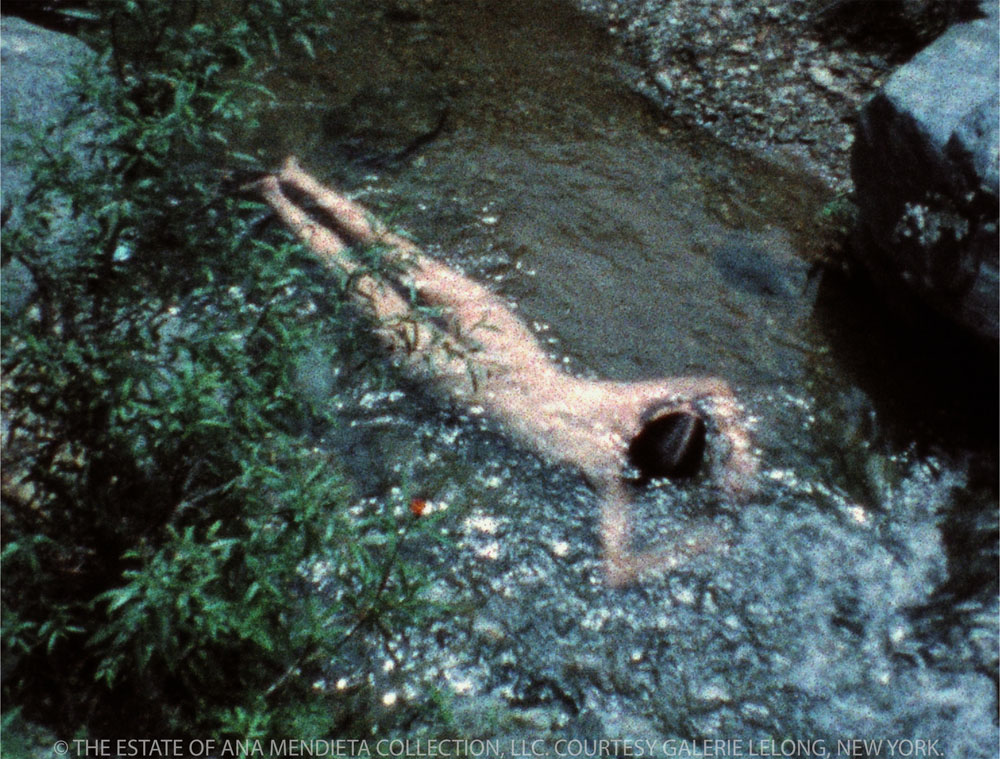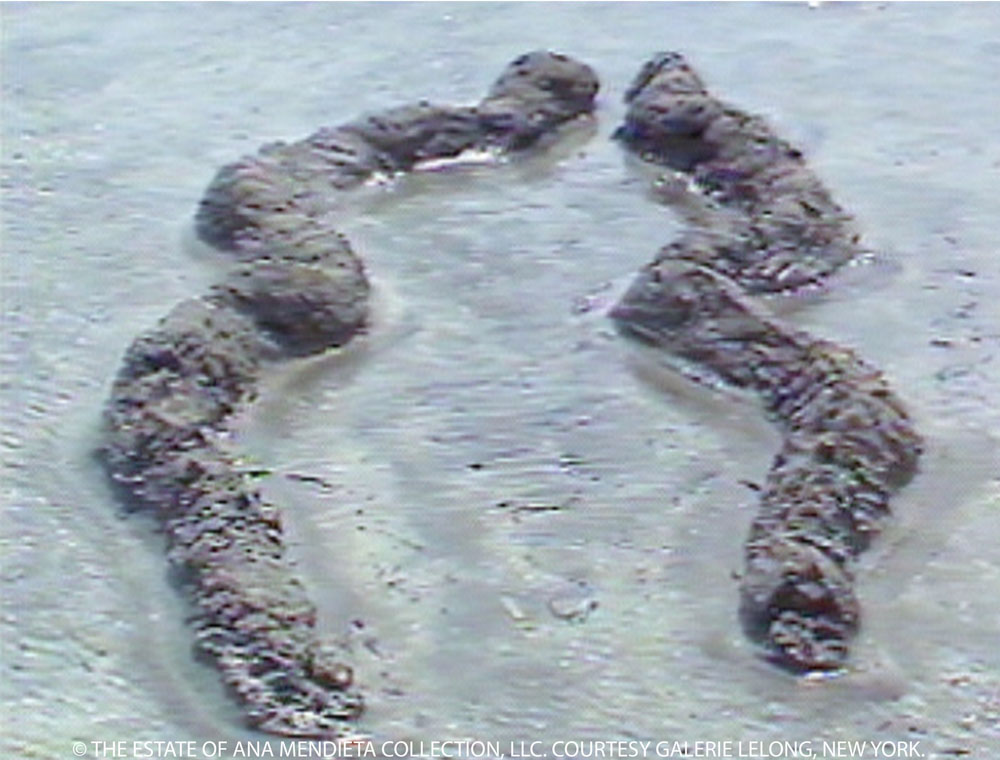Cheating Death: The Moving Images of Ana Mendieta
Even 30 years after her death, viewed in light of current political battles over women’s autonomy and equality, the silent imagery in Ana Mendieta's film works have never felt more urgent, necessary, and emphatically vocal.

Now at the Katherine E. Nash Gallery is Covered in Time and History: The Films of Ana Mendieta, showing 21 of the artist’s film works and 26 related photographs, comprising the largest collection of Mendieta’s films presented in the United States as a full-scale gallery exhibition. Curated by Lynn Lukkas, Chair of the Department of Art at the University of Minnesota, and Howard Oransky, the gallery’s director, Covered in Time and History is the result of three years of research done by the University of Minnesota and the Estate of Ana Mendieta Collection on the artist’s moving image practice.
Running as it is, almost 30 years after Mendieta’s untimely death on September 8, 1985, the show is cast in a light of mourning, loss, and remembrance of the artist who achieved so much in just 37 years. This timing, coupled with her work’s seemingly second-wave feminist ethos, puts her film works at risk of historicization—a temptation to see them through the nostalgic lens of a career and life that could have been. Yet the experience of these pieces in the Nash Gallery offers much more than mere historical interest. Viewed in light of current political battles for women’s autonomy and equality, Mendieta’s films have never felt more urgent, necessary, and emphatically vocal in their silent imagery.
The seven rooms of the exhibition are spare; none of the 21 film works have accompanying object labels. This allows for an uninterrupted consumption of the images. In order to place a given filmwork in front of you chronologically or geographically, you must wait for the video to loop back to the beginning credits, facilitating a simpler navigation of space, a more intimate engagement with the work. It is unnecessary to walk up to the projection and read a label, which itself unifies the experience of these pieces into a cohesive narrative.

The silent super-8 videos initially appear still due to their static frames. On closer inspection, however, the filmworks are clearly animate. A mound of brush in the shape of a human figure (Mendieta’s iconic Silueta) catches fire, and smoke billows up and out of the frame of the shot. Mendieta’s Creek (1974) frames the end of the room; a particularly haunting and beautiful example of her filmwork: A female body, Mendieta herself, lays chest down in the bed of a creek, water rushing onto her skin. She remains stationary, framed by the bank of the creek and surrounding flora. Her slender figure, bent at the waist, white as porcelain, recalls statuary from ancient Greece, pure white marble carved into the ideal of femininity.
This allusion to mythology, magic, and myth, circulates throughout Mendieta’s work; a way to reconnect to the terrain the artist must have felt displaced from as a forced evacuee from Cuba to the United States in 1961. In a documentary video included in the exhibition, Mendieta recounts, “I realized that my paintings were not real enough for what I want the image to convey; and by real, I mean I wanted my images to have power, to be magic.” The female body is ever-present within these works, whether in totality (Mendieta’s body in the previously described Creek), in index (earth imprinted with Silueta in Ochún, 1981), or icon (vulvic mounds of earth in Volcán of 1979).


In spite of the work’s exploration of the mythological female, it would be reductive to trap these films solely within the second-wave feminist art of the 1960s and ’70s. Certainly, the reappropriation of the female body and its connection to the earth, to primitive cultures, and to the elements is present. Indeed, the works’ historical moment is recalled in Blood Inside Outside of 1975, in which Mendieta paints her naked body with animal blood on a riverbank (not surprisingly, completed in the same year as Carolee Schneeman’s own iconic Interior Scroll). But Mendieta’s performativity refuses easy categorization as a mere vestige of a bygone feminism. Rather, thanks in large part to their medium, these filmworks engage in the moment. Forced to deal with the short, looped videos, the audience traverses the gallery, acutely aware of the temporality of their contents. Mendieta proffers her body across generations through film, leaving her audience to relate to her image as an emphatic and present agent.
The most evocative example of the atemporality of these filmworks is Sweating Blood from 1973. The show exhibits two videos, Moffitt Building Piece, and Sweating Blood, and one photographic series, Self-Portrait with Blood, in response to the sexual assault and murder of University of Iowa student Sarah Ann Ottens in 1973. While Moffitt Building Piece, which recorded unsuspecting passersby in Iowa City as they came upon a pile of blood and viscera on the street, feels heavy-handed, Sweating Blood is relatively subtle, an illustrative image of the silent rage of the female condition. The piece is aesthetically simple but technically complex, leaning more heavily upon medium specificity than its surrounding filmworks. Mendieta’s face, with eyes closed, appears in the projection; slowly, by way of numerous takes, droplets of blood accumulate upon her brow. The blood-sweat appears to seep through her pores, resulting finally in blood pooling into the inner corner of the artist’s closed eye, completing the metaphor of the blood, sweat, and tears that women endure as they witness the violent misogyny perpetrated by patriarchal order, yesterday and today.

Burial Pyramid (1974) is an apt visual metaphor for the crux of the show. In the piece, Mendieta lays on the ground covered by a pile of rocks. Through the simple act of breathing, heaving her chest up and down, she begins to uncover herself, breaking free from her geologic captor. Mendieta depicts resurrection through the simple act of existence, just as the presence of her work carries her legacy and urgent work on for new generations long after her death. No, Covered in Time and History is much less about time and history, about a failed feminist cultural revolution or a life cut short, than it is about these moving images, and Mendieta’s spirit, cheating death.
Related exhibition information: Covered in Time and History: The Films of Ana Mendieta is on view at the Katherine E. Nash Gallery, University of Minnesota, Twin Cities campus, through December 12, 2015.